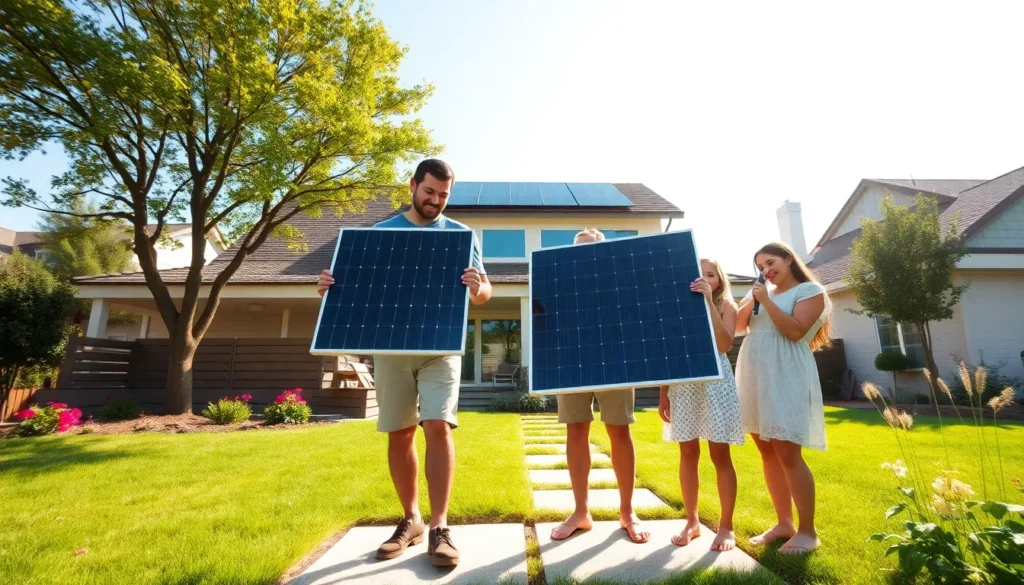In an age where sustainability is becoming increasingly vital, many homeowners are looking for ways to reduce their energy consumption and reliance on fossil fuels. DIY solar solutions present an exciting opportunity for those seeking to make their homes more energy-efficient. This comprehensive guide will explore everything from understanding solar power to the benefits of DIY installations and the best kits suited for individual needs. By the end of this article, readers will be equipped with the knowledge needed to embark on their solar journey confidently.
Table of Contents
ToggleUnderstanding Solar Power for Homes

Solar power harnesses energy from the sun, converting it into electricity through photovoltaic (PV) cells found in solar panels. This renewable energy source is not only sustainable but also abundant, making it a perfect fit for home energy solutions.
Solar panels can be installed on rooftops or in yards, allowing flexibility depending on the layout and size of the property. Systems are designed to convert sunlight into electricity, which can be used to power household appliances, lights, and electronics.
Also, solar power systems can be designed for grid-tied, off-grid, or hybrid configurations, providing homeowners with various choices to meet their specific energy needs.
Benefits of DIY Solar Installations
Installing a DIY solar system has numerous benefits:
- Cost Savings: By opting for a DIY solar project, homeowners can save on labor costs that typically contribute significantly to the overall expense of a solar installation.
- Increased Property Value: Homes equipped with solar energy systems often have higher property values and attract more potential buyers due to the growing interest in sustainable living.
- Energy Independence: Generating your own electricity allows homeowners to reduce or eliminate their reliance on utility companies, giving them greater control over their energy consumption.
- Environmental Impact: Solar energy is clean and renewable, leading to a lower carbon footprint compared to traditional energy sources. Using solar power contributes to a more sustainable future.
Choosing the Right Solar Kit for Your Needs
When selecting a solar kit for a DIY installation, several factors should be considered:
- Energy Needs: Assess how much power the household consumes and choose a kit that can meet those demands. Homeowners can examine their utility bills for insights into current energy consumption.
- Quality of Components: Look for solar kits that include high-quality solar panels, inverters, and mounting equipment. Research brands and read customer reviews to ensure reliability.
- Ease of Installation: Some kits come with comprehensive manuals and customer support, making the installation process smoother. Make sure to choose a kit that suits your skill level.
Step-by-Step Guide to Installing Your DIY Solar System
Installing a DIY solar system may seem daunting, but breaking it down into manageable steps can simplify the process. Here’s a step-by-step guide:
- Plan Your Layout: Determine where the panels will be placed and ensure that the selected location receives ample sunlight throughout the day.
- Gather Your Tools: Prepare necessary tools, such as wrenches, screwdrivers, and a drill.
- Install Mounting Hardware: Secure brackets or mounts where the solar panels will be located.
- Connect the Solar Panels: Attach the solar panels to the mounts according to the manufacturer’s instructions.
- Install the Inverter: Connect the solar panels to the inverter, which converts the generated DC electricity to AC, making it usable in a typical home.
- Connect to the Electrical System: Finally, connect the inverter to the home’s electrical system, following local electrical codes.
Integrating Solar Energy with Existing Home Systems
Integrating a solar energy system with existing home setups can enhance overall efficiency:
- Smart Home Devices: Use smart home technology to optimize energy usage. Smart thermostats and appliances can be programmed to run during peak solar production times, enhancing savings.
- Battery Storage Systems: For those with an off-grid system or wanting to store excess energy, integrating battery systems can provide stored energy for use during nighttime or cloudy days.
- Solar Water Heating: Consider combining solar panels with solar water heating systems to improve energy efficiency in water heating, further reducing energy bills.
Potential Challenges and Solutions When Going Solar
While the advantages of solar power are significant, there may be challenges:
- Space Limitations: Not all homes can accommodate solar panels on roofs: in such cases, ground-mounted systems might be an alternative.
- Initial Costs: DIY solar can have upfront costs before seeing savings. Financial incentives, rebates, and tax credits can help mitigate these expenses.
- Weather Dependence: Solar energy production can fluctuate based on weather conditions. Investing in a battery storage system can help ensure availability when solar generation is low.
The Role of Renewable Energy in Sustainable Living
Renewable energy sources, including solar, wind, and hydro, play a crucial role in sustainable living. By investing in renewable energy:
- Resource Conservation: Reducing reliance on non-renewable resources helps conserve the Earth’s resources for future generations.
- Economic Benefits: Transitioning to renewable energy creates job opportunities in manufacturing, installation, and maintenance of solar technologies.
- Global Climate Impact: The shift toward renewable energies is essential in combating climate change. Using solar energy can significantly reduce greenhouse gas emissions, contributing to a healthier planet.
Conclusion
DIY solar installations offer a pathway to greater energy efficiency and sustainability for homeowners. With comprehensive knowledge about solar power, its benefits, and the step-by-step installation process, anyone can harness this clean energy source. By embracing solar technology, not only do homeowners save money and increase their property values, but they also contribute positively to the environment. As society continues to prioritize sustainable living, the journey toward adopting solar energy becomes not just beneficial but essential.






